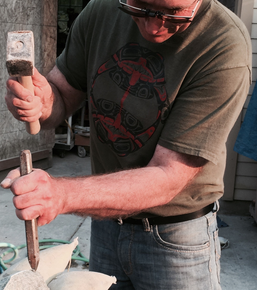Camp Brotherhood Steinhauersymposium
Last evening Verena Schwippert and Knut Hueneke (one of this year’s guest artists at campB) stopped by and we had a chance to talk and carve stone.
For this symposium, his message, and what he wants to teach is pretty straightforward: Hand tool techniques to sculpt hard stone are a useful addition to a carver’s toolkit and makes for a different experience in understanding a stone than those provided by a spinning diamond tool. He was clear that each technique has benefits and none are better or worse than others, just useful at the right time.
His point of view is:
- Learning how to use a spinning diamond tool is easy once you understand the geometry it creates. Given the ease and power, you can quickly create forms. It is also likely, that unless you are very observant, little will be revealed about the structure and the essential nature of the stone you are working on.
- Learning how to use a "rocko" or "hand set" or “plain and point” chisel to shape a stone, particularly basalt and granite, which tend to have a uniform crystalline structure, causes you to better understand the nature of the stone you are working with.
He demonstrated with some stone from my cobble pile. He split a 7-9" basalt egg shape, a 6-7" peridotite river cobble, and attempted to split a 9-10" dunite (olivine) river rock with lots of river damage but instead, due to the nature of dunite, he ended up working its core surfaces.
The basalt egg shape split along the intended line and followed the general shape of the stone, and had a slight concave/convex internal shape. The crystal structure was fine grain, uniform and revealed a black interior. It took surprisingly few blows to split.
I have worked dunite and peridotite river cobbles, and know that sometimes what looks like cracks can be superficial. The peridotite cobble he thought he would split along what looked like a surface crack. It split, but the split didn't follow what turned out to be a superficial crack, but rather reflected the river formed shape. Its interior crystal structure looked like small fish scales with thin small yellow-green fish scale size inclusions. A good lesson about peridotite.
The dunite cobble did not split along a crack either, but rather spaulded off along the river-beaten rind. As he worked around the cobble to split it, the rind came off instead. A lot of rind came off quickly leaving a solid and much smaller core, reflecting the original shape and revealing what are familiar rhomboid faces of a solid olivine core. Fracture planes in olivine tend to form along rough large and uneven crystalline faces. His technique revealed olivine's structure, roughly showing the nature of the stone he was working.
Knut’s use of the hand tools for the basalt and peridotite splitting, and working of the olivine, were good lessons and worth learning for use on hard stone, and maybe on some softer stones. After watching him I can also see the benefit of using this on larger pieces of hard stone and would consider using hand tools for John Fisher’s idea of “removing 30%” to see what’s in the stone. (Never thought I’d hear myself say that regarding basalt).
For those attending the Camp B symposium take the time to work with him during the week. And for those who can spare a day to drop by, please come to hear what he has to say.






